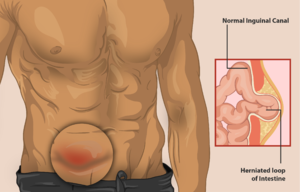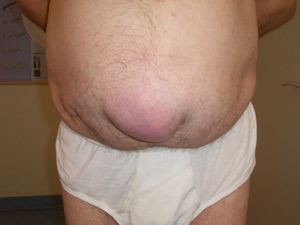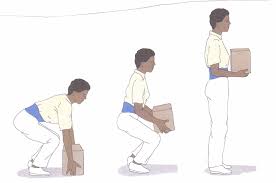Hernia
This article is currently under review and may not be up to date. Please come back soon to see the finished work! (21/05/2020)
Original Editors -
Top Contributors - Lucinda hampton, Kim Jackson, Admin, Nehal Shah, WikiSysop and Claire Knott
Introduction[edit | edit source]
A hernia occurs when an organ or fatty tissue squeezes through a weak spot in a surrounding muscle or connective tissue called fascia.
The most common types of hernia are[1]:
- Inguinal (inner groin) see R image
- Incisional (resulting from an incision)
- Femoral (outer groin)
- Umbilical (belly button) see image R second down.
- Hiatal (upper stomach).
Causes[edit | edit source]
All hernias are caused by a combination of pressure and an opening/weakness of muscle or fascia; the pressure pushes an organ or tissue through the opening or weak spot. Sometimes the muscle weakness is present at birth; more often, it occurs later in life.
Anything that causes an increase in pressure in the abdomen can cause a hernia, including:
- Lifting heavy objects without stabilizing the abdominal muscles
- Diarrhea or constipation
- Family History—Although family history may not guarantee a hernia, research shows it is a reliable predictor of one occurring.
- Persistent coughing or sneezing
- Obesity, poor nutrition, and smoking (all weaken muscles and make hernias more likely).
- Pregnancy—The risk is small, but studies show that pregnancy is associated with an increase in the risk of hernia recurrence.
- Injury—Most sports-related hernias occur in the groin and don’t appear as a bulge. But if left untreated, it can evolve into an inguinal hernia[2].
Types[edit | edit source]
- Inguinal hernia - the intestine or the bladder protrudes through the abdominal wall or into the inguinal canal in the groin.
- About 96% of all groin hernias are inguinal, and most occur in men because of a natural weakness in this area.
2. Incisional hernia - the intestine pushes through the abdominal wall at the site of previous abdominal surgery.
- This type is most common in elderly or overweight people who are inactive after abdominal surgery.
3. Femoral hernia - occurs when the intestine enters the canal carrying the femoral artery into the upper thigh.
- Femoral hernias are most common in women, especially those who are pregnant or obese.
4. Umbilical hernia - part of the small intestine passes through the abdominal wall near the navel.
- Common in newborns, it also commonly afflicts obese women or those who have had many children.
5. Hiatal hernia - upper stomach squeezes through the hiatus, an opening in the diaphragm through which the esophagus passes.
Prevention[edit | edit source]
Tips to Decrease the Risk of a Hernia
- Maintain a healthy weight. Rapid weight loss and weight gain place pressure on the abdominal wall.
- Don’t smoke.
- Change lifting stance. Lift with the legs, not the back.
- Change your diet to improve bowel movements. Increasing fiber intake may help to relieve constipation that can cause straining during bowel movements, which can aggravate a hernia. Some examples of high-fiber foods include whole grains, fruits, and vegetables.
- Dietary changes can also help with the symptoms of a hiatal hernia. Try to avoid large or heavy meals, don’t lie down or bend over after a meal, and keep your body weight in a healthy range.
- To prevent acid reflux, avoid foods that may cause it, such as spicy foods and tomato-based foods.[1]
Treatment[edit | edit source]
Whether or not surgery is performed depends on the size of the hernia and the severity of symptoms.
- The doctor may want to simply monitor your hernia for possible complications ie watchful waiting.
- In some cases, wearing a truss may help to ease the symptoms of a hernia (supportive undergarment that helps to hold the hernia in place).
- If you have a hiatal hernia, over-the-counter and prescription medications that reduce stomach acid can relieve discomfort and improve symptoms. These include antacids, H-2 receptor blockers, and proton pump inhibitors.[3]
If the hernia is growing larger or causing pain surgeons may decide it’s best to operate. Repair may be by sewing the hole in the abdominal wall closed during surgery. This is commonly done by patching the hole with surgical mesh.
Hernias can be repaired with either open or laparoscopic surgery.
- Laparoscopic surgery uses a tiny camera and miniaturized surgical equipment to repair the hernia using only a few small incisions. It’s also less damaging to the surrounding tissue.
- Open surgery, the surgeon makes an incision close to the site of the hernia, and then pushes the bulging tissue back into the abdomen. They then sew the area shut, sometimes reinforcing it with surgical mesh. Finally, they close the incision[3].
Diagnostic Procedures[edit | edit source]
Can include ( after medical history taken)
- abdominal ultrasound - high-frequency sound waves to create an image of the structures inside the body
- CT scan, which combines X-rays with computer technology to produce an image
- MRI scan
If a hiatal hernia is suspected other tests that allow them to assess the internal location of your stomach may be ordered:
Gastrografin or barium X-ray, which is a series of X-ray pictures of your digestive tract. The pictures are recorded drinking a liquid containing diatrizoate meglumine and diatrizoate sodium (Gastrografin) or a liquid barium solution. Both show up well on the X-ray images.
Endoscopy, which involves threading a small camera attached to a tube down the throat and into esophagus and stomach.[3]
Physical Therapy Management[edit | edit source]
The main goal of physiotherapy is to:
Reduce pressure off the tissue (e.g. addressing poor breathing mechanics)
Strengthen the supporting tissue (e.g. deep core strengthening)
Apply compression support to assist
Reduce aggravating activities and gradually re-introduce eg Avoid eg weight lifting or exercises that strain the abdomen, may increase pressure at the area of the hernia (cause the hernia to bulge more). The same is true for exercises that are done improperly.
- Exercise may work to strengthen muscles around the hernia and promote weight loss, helping reduce some symptoms.
- A study from 2018[3]investigated the effects of an exercise program on obese individuals who were to undergo ventral hernia repair surgery. It was observed that people who completed the exercise program had less complications following surgery.
Key Research[edit | edit source]
add links and reviews of high quality evidence here (case studies should be added on new pages using the case study template)
Resources[edit | edit source]
add appropriate resources here
Clinical Bottom Line[edit | edit source]
add text here
References[edit | edit source]
see adding references tutorial.
- ↑ 1.0 1.1 wdmed Hernias the basics Available from:https://www.webmd.com/digestive-disorders/understanding-hernia-basics (last accessed 21.5.2020)
- ↑ Utahhealth Hernias Available from:https://healthcare.utah.edu/healthfeed/postings/2018/02/hernia.php (last accessed 21.5.2020)
- ↑ 3.0 3.1 3.2 3.3 Healthline Hernias Available from:https://www.healthline.com/health/hernia#treatment (last accessed 21.5.2020)










